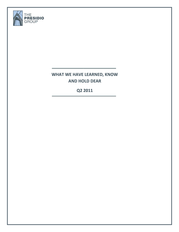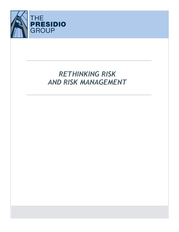Description
PAGE 11
DEFINITIONS OF INDICES
Lipper General Municipal Debt Fund Index - The Lipper General Municipal Debt Index represents
average performance of the largest general municipal debt funds tracked by Lipper Analytical
Services.
MSCI All Country World Index - The MSCI All Country World Index is a free float-adjusted marketcapitalization-weighted index that is designed to measure the equity market performance of
developed and emerging markets. The MSCI ACWI consists of 45 country indices comprising 24
developed and 21 emerging-market country indices.
HFRX Absolute Return Index - The HFRX Absolute Return Index is designed to be representative of
the overall composition of the hedge fund universe. It is comprised of all eligible hedge fund
strategies; including but not limited to convertible arbitrage, distressed securities, equity hedge,
equity market neutral, event driven, macro, merger arbitrage, and relative value arbitrage. Hedge
Fund Research, Inc utilizes a methodology based on defined and predetermined rules and objective
criteria to select and rebalance components to maximize representation of the Hedge Fund Universe.
These insights come from Presidio Capital Advisors LLC, a SEC Registered Investment Advisory firm, is
a subsidiary of The Presidio Group LLC.
There are no warranties, expressed or implied as to the accuracy, completeness, or results obtained from any information in this material. Past performance does not guarantee future results. This material is proprietary and is not allowed to be reproduced, other than for your own persona, noncommercial use, without prior written permission from Presidio. Published January 2014 © 2014 All rights reserved. Models, extracted performance, and hypothetical results have inherent limitations and may be based on certain assumptions.
Some or all investment programs may not be suitable for all investors. Actual performance may vary based on allocations, fees, and/or other factors unique to a portfolio. .
There are no warranties, expressed or implied as to the accuracy, completeness, or results obtained from any information in this material. Past performance does not guarantee future results. This material is proprietary and is not allowed to be reproduced, other than for your own persona, noncommercial use, without prior written permission from Presidio. Published January 2014 © 2014 All rights reserved. Models, extracted performance, and hypothetical results have inherent limitations and may be based on certain assumptions.
Some or all investment programs may not be suitable for all investors. Actual performance may vary based on allocations, fees, and/or other factors unique to a portfolio. .









